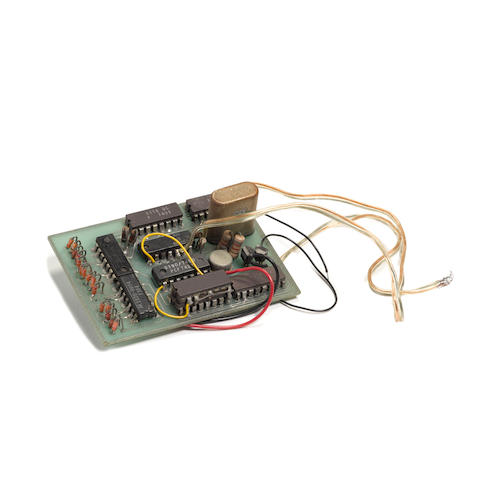
“If it weren't for the blue boxes, Apple wouldn't exist. I'm 100% sure of that. " - Steve Jobs
Although phreakers (phone system geeks) used blue boxes to access toll-free telephone services as early as the 1950s, the first digitalThe blue box was designed by Steve Wozniak in 1972. It was advertised and marketed by Wozniak himself (who took the phreaker name "Berkeley Blue"), Jobs (known as "Oaf Tobar") and their friends in Berkeley and throughout California in 1972 and 1973. Wozniak said they made 40-50 devices, and Jobs claimed a hundred; but it is certain that many of the boxes were confiscated when the phreaker arrests intensified in 1973-1975; this was partly due to the commercial distribution of the devices. These blue boxes are the result of the first commercial collaboration between the two giants who founded Apple, and their printed circuit boards became Woz's first experience in making a circuit board.
Very few devices made by Wozniak himself have survived to this day, and even fewer of the first versions of such boards remain - Wozniak soon changed the structure of the printed circuit board to use a cheaper membrane keyboard in it.The first models were produced by Wozniak himself. In 1971, Esquire magazine published an article "Secrets of the Little Blue Box" with the subtitle "A story so incredible that it will make you sympathize with the phone company." The article described a group of engineers who figured out how to hack Bell's automatic switching systems by freely roaming Bell's long-distance telephone systems using special frequencies generated by blue boxes. The story of these "phone phreakers" became a sensation, and a particularly important reader was a young Berkeley engineering student named Steve Wozniak. As Wozniak recalls, the first thing after reading the article, he called his good friend Steve Jobs, who was still in high school.The next day, they jumped into Woz's car and headed to the Stanford Linear Accelerator library to search the shelves for clues that would allow them to refine the details of the Esquire.

Blue box
According to Wozniak's recollections, they found them: “I froze, grabbed Steve and almost screamed with delight. We looked at the list with an adrenaline rush. We only repeated something like "Uh, ...!" And "Wow, this is actually true!" I was literally shaking and shivering down my spine. It was a real eureka moment. " (Wozniak, p. 100). Returning to Berkeley, they enthusiastically discussed the possibility of creating a "blue box", and three weeks later Wozniak invented it. After realizing that the frequencies produced by the analog blue box were highly biased, he designed the first digital blue box. In his biography, he recalls: “I swear, and to this day I am most proud of the design of this board: a set of parts capable of performing not two, but three tasks simultaneously. I still think it was incredible ”(Wozniak, p.102).
Over the next few weeks, thanks to the unexpected help of Captain Crunch, blue box maker John Draper, who was mentioned in the Esquire article and instantly became a hacker and phreaker hero, Wozniak refined the design, resulting in the world's first digital blue box capable of creating much a more stable frequency than previous analog devices. With the blue box in hand, two young people and their friends began to explore the telephone system, which led to the famous story of Wozniak: he called the Vatican, introduced himself as Henry Kissinger and called the Pope to the phone (unfortunately, at that time he was asleep) ... Soon after, Jobs came up with a plan to distribute these devices to Berkeley students who want to make free phone calls.They knocked on the random door of the Berkeley dorm and asked for a man with an invented name, who, of course, never showed up. They explained that they were looking for a guy who makes free phone calls with a blue box.
If the interlocutor expressed interest or curiosity, then they sold him the box. Thanks to Jobs' ingenious marketing plan and Wozniak's architecture, they were able to raise about $ 6,000 on the project by assembling $ 40 devices and selling them for $ 150. According to Bill Claxton, whom Captain Crunch met in the dorm when he first met Woz, the first blue boxes used hard keys that were quickly replaced with soft keyboards to make the devices cheaper. Recalling this whole story, Steve Jobs observed: "Woz and I learned to work together and developed the confidence that we can solve technical problems and actually produce something."
List of references
1. Lapsley, Phil. Exploding the Phone: the Untold Story of the Teenagers and Outlaws Who Hacked Ma Bell. (New York, 2013).
2. Wozniak, Steve. IWoz: Computer Geek to Cult Icon (New York, 2006).
3. Isaacson, Walter. Steve Jobs. (New York, 2011).
Recently, one of the first blue boxes created by Wozniak (pictured at the beginning of the article) was sold at Bonhams auction for $ 31,325 (about 2.4 million rubles).